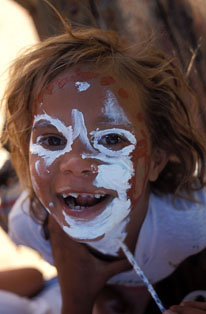
Aboriginal girl, Doomadgee
I just finished watching the fantastic ABC TV special tonight “The New Black” with short films averaging about 10 minutes telling Aboriginal stories. Wow! It was incredibly insightful about really pertinent issues such as rape, neglect, adoption, relationships and childhood in both Aboriginal communities and in the city.
Some of it was bleak, a lot was tough going but I often measure stories like this by the impact they have on me personally. And these films made me rethink experiences I have had with Aboriginal people both as a child at school when I might not really have been aware of issues going on for some of my Aboriginal classmates. And as an adult doing voluntary work in several Aboriginal communities and probably not fully grasping what’s involved in the drinking, truancy, suicide and relationships.
If these stories impacted me so personally and sensitively I can only hope that they have done the same for others. The incredible power of these stories are they are actually directed and written by Aboriginal people. They are telling their own stories and that is incredibly empowering both for them as a story telling people and for the wider Australian population. The director of Samson and Delilah, Warwick Thornton, said on the special that there is a real hunger amongst the Australian population for these stories. I hope more are told and more people see them.
Which reminds me I still need to put the finishing touches to my Doomadgee Memoirs book, telling the lives of six people in a far north Queensland community. I’m still waiting for three signatures so I can print the book but I might just have to go ahead with only the three I have. You can read more about this project here: https://www.visitedplanet.com/page.php?f=doomadgee
——–
Feel free to email Jo at [email protected] with your comments/thoughts/photo aspirations. See and learn more at www.visitedplanet.com











